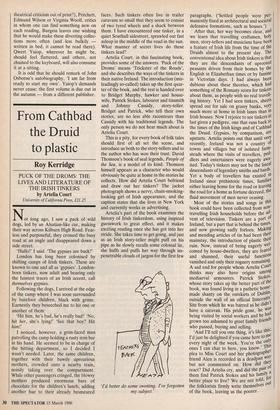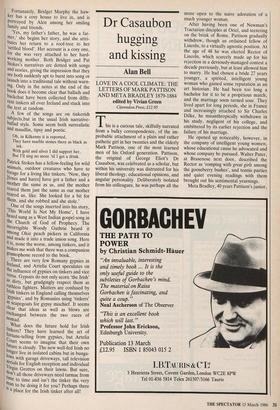From Cathbad the Druid to plastic
Roy Kerridge
PUCK OF THE DROMS: THE LIVES AND LITERATURE OF THE IRISH TINKERS by Artelia Court
University of California Press, £21.25
Not long ago, I saw a pack of wild dogs, led by an Alsatian-like cur, making their way across Kilburn High Road. Fear- less and purposeful, they crossed the busy road at an angle and disappeared down a side street.
'Hullo!' I said. 'The gypsies are back!'
London has long been colonised by shifting camps of Irish tinkers. These are known to one and all as 'gypsies'. London- born tinkers, now adult and bearing only the faintest traces of an Irish accent, call themselves gypsies.
Following the dogs, I arrived at the edge of the camp where I was soon surrounded by barefoot children, black with grime. Earnestly they beseeched me to hit one or another of them: 'Hit him, he's had, he's really bad!"No, hit her, she's lying!' See that boy? Hit him!'
I noticed, however, a grim-faced man patrolling the camp holding a rusty iron bar in his hand. He seemed to be in charge of the hitting department, so I decided I wasn't needed. Later, the same children, together with their bawdy uproarious mothers, crowded onto a nearby train, noisily taking over the compartment. While other passengers cringed, the blowsy mothers produced enormous bars of chocolate for the children's lunch, adding another hue to their already besmeared faces. Such tinkers often live in trailer caravans so small that they seem to consist of two tyred wheels and a shack between them. I have encountered one tinker, in a quiet Southall sidestreet, sprawled out fast asleep in the middle of the road in the sun. What manner of secret lives do these tinkers lead?
Artelia Court, in this fascinating book, provides some of the answers. 'Puck of the Droms' means 'Trickster of the Roads', and she describes the ways of the tinkers in their native Ireland. The introduction (mis- leadingly so-called) takes up the first quar- ter of the book, and the rest is handed over to Bridget Murphy, hawker and house- wife, Patrick Stokes, labourer and tinsmith and Johnny Cassidy, story-teller. Bridget and Patrick, who tell their own stories, are no less able raconteurs than Cassidy with his traditional legends. The only person we do not hear much about is Artelia Court.
This is a pity, for every book of folk tales should first of all set the scene, and introduce us both to the story-tellers and to the author who has won their trust. David Thomson's book of seal legends, People of the Sea, is a model of its kind. Thomson himself appears as a character who would obviously be quite at home in the stories he collects. How did Artelia Court befriend and draw out her tinkers? The jacket photograph shows a nervy, chain-smoking- looking girl of Irish appearance, and the caption states that she lives in New York and currently works in advertising.
Artelia's part of the book examines the history of Irish tinkerdom, using inspired guesswork to great effect, and it makes exciting reading once she has got into her stride. She takes time to get going, and just as an Irish story-teller might puff on his pipe as he slowly recalls some colossal lie, she huffs and puffs her way through im- penetrable clouds of jargon for the first few 'I'd better do some swotting. I've forgotten my subject.' paragraphs. (`Settled people were per- manently fixed in architectural and societal defensive formations, such as houses.') After that, her way becomes clear, and we learn that travelling craftsmen, holy men, story-tellers and musicians have been a feature of Irish life from the time of the Druids almost to the present day. The conventional idea about Irish tinkers is that they are the descendants of uprooted peasants driven from their homes by the English in Elizabethan times or by famine in Victorian days. I had always been dubious about these theories, which had something of the Romany scorn for tinkers about them, as people with no real travell- ing history. Yet I had seen tinkers, sheets spread out for sale on grassy banks, verY much more at home in Irish lanes than in Irish houses. Now I rejoice to see tinkers at last given a pedigree, one that runs back to the times of the Irish kings and of Cathbad the Druid. Gypsies, by comparison, are upstarts. Artelia points out that until verY recently, Ireland was not a country of towns and villages but of isolated foal' steads where the visits of travellers, ped- dlers and entertainers were eagerly awa- ited. Today's tinkers may not be the lineal descendants of legendary smiths and bards. Yet a body of travellers has existed .10 Ireland since prehistoric times, families either leaving home for the road or leaving the road for a home as fortune decreed, the fluid movement of men never ceasing. . Most of the stories and songs in this book could have been collected from 1.109- travelling Irish households before the ad- vent of television. Tinkers are a part 01 Ireland, but a part that is behind the tlines' and now growing sadly forlorn. Making and mending articles of tin had been thel.r mainstay, the introduction of plastic their ruin. Now, instead of being eagerly wet comed by house-dwellers, they are feareu and shunned, their useful functions vanished and only their roguery remaining. A sad end for people whom Artelia Court thinks may also have origins ani014 mediaeval armourers. Patrick Stokes' whose story takes up the better part of the book, was found living in a pathetic hoar' made shanty on the outskirts of DtiblIn; outside the wall of an official Itinerants, Site from which he was barred as he didn t have a caravan. His pride gone, he wasd being visited by social workers and he haA grown too ashamed to greet family frterlus who passed, buying and selling. 'And I'll tell you one thing, it's like this; I'd just be delighted if you came here to Me every night of the week. You're the orgy ones I can chat to here, you know.' Tills plea to Miss Court and her photographer friend Men is recorded in a deadpan viaY but not commented on. How did t.heYf react? Did Artelia cry, and did the pail them find Patrick Stokes and his familY better place to live? We are not told, for the folklorists firmly write themselves 001 of the book, leaving us the poorer. Fortunately, Bridget Murphy the haw- ker has a cosy house to live in, and is Portrayed by Alen among her smiling family and friends.
'Yes, my father's father, he was a far- mer,' she begins her story, and she attri- butes her return to a roof-tree to her 'settled blood'. Her account is a cosy one, for she was very attached to her hard- working mother. Both Bridget and Pat Stokes's narratives are dotted with songs and stories, giving the impression that they are both suddenly apt to burst into song or launch into a traditional tale without warn- Mg. Only in the notes at the end of the book does it become clear that ballads and backchat have been collected from diffe- rent tinkers all over Ireland and stuck into the text at random.
A few of the songs are on tinkerish subjects,but in the usual Irish narrative- ballad style. Some seem both surrealistic and maudlin, tipsy and poetic.
Oh, in Kilkenny it is reported, They have marble stones there as black as ink.
With gold and silver I did support her, But I'll sing no more 'til I get a drink.
Patrick Stokes has a fellow-feeling for wild animals, outdoor creatures who have to forage for a living like tinkers. 'Now, they [foxes and hares] have got a father and a mother the same as us, and the mother reared them just the same as our mother reared us, like. She looked for a bit for them, and she robbed and she stole.'
, One of the songs inserted into his story, This World Is Not My Home', I have heard sung as a West Indian gospel song in the Church of God of Prophecy. The Incorrigible Woody Guthrie heard it among Okie peach pickers in California and made it into a trade union song. Here It is, none the worse, among tinkers, and it makes me wish that there was a companion gramophone record to the book. There are very few Romany gypsies in Ireland, and Artelia Court speculates on the influence of gypsies on tinkers and vice versa. Gypsies do not only scorn 'the Irish' as dirty, but grudgingly respect them as ruthless fighters. Matters are confused by Irish tinkers in England calling themselves gypsies', and by Romanies using 'tinkers' as scapegoats for gypsy mischief. It seems Clear that ideas as well as blows are exchanged between the two races of nomad.
. What does the future hold for Irish tinkers? They have learned the art of fortune-telling from gypsies, but Artelia Court seems to imagine that their own future is cloudy. The new well-fed Irish no ienger live in isolated cabins but in bunga- °Ws with garage driveways, tall television ,artals for English reception and individual trgin Grottos on their lawns. But sure, all those driveways need tarmac from tnrle to time and isn't the tinker the very !Ilan to be doing it for you? Perhaps there 18 a place for the Irish tinker after all!



















































 Previous page
Previous page